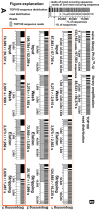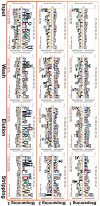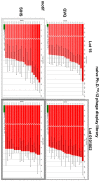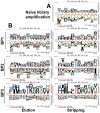Application of Next Generation Sequencing (NGS) in Phage Displayed Peptide Selection to Support the Identification of Arsenic-Binding Motifs
- PMID: 33261041
- PMCID: PMC7759992
- DOI: 10.3390/v12121360
Application of Next Generation Sequencing (NGS) in Phage Displayed Peptide Selection to Support the Identification of Arsenic-Binding Motifs
Abstract
Next generation sequencing (NGS) in combination with phage surface display (PSD) are powerful tools in the newly equipped molecular biology toolbox for the identification of specific target binding biomolecules. Application of PSD led to the discovery of manifold ligands in clinical and material research. However, limitations of traditional phage display hinder the identification process. Growth-based library biases and target-unrelated peptides often result in the dominance of parasitic sequences and the collapse of library diversity. This study describes the effective enrichment of specific peptide motifs potentially binding to arsenic as proof-of-concept using the combination of PSD and NGS. Arsenic is an environmental toxin, which is applied in various semiconductors as gallium arsenide and selective recovery of this element is crucial for recycling and remediation. The development of biomolecules as specific arsenic-binding sorbents is a new approach for its recovery. Usage of NGS for all biopanning fractions allowed for evaluation of motif enrichment, in-depth insight into the selection process and the discrimination of biopanning artefacts, e.g., the amplification-induced library-wide reduction in hydrophobic amino acid proportion. Application of bioinformatics tools led to the identification of an SxHS and a carboxy-terminal QxQ motif, which are potentially involved in the binding of arsenic. To the best of our knowledge, this is the first report of PSD combined with NGS of all relevant biopanning fractions.
Keywords: Illumina; NGS; arsenic; biopanning; interaction; motif; oxyanion; peptide; phage display; target-unrelated peptide.
Conflict of interest statement
The authors declare no conflict of interest.
Figures













Similar articles
-
Phage display biopanning and isolation of target-unrelated peptides: in search of nonspecific binders hidden in a combinatorial library.Amino Acids. 2016 Dec;48(12):2699-2716. doi: 10.1007/s00726-016-2329-6. Epub 2016 Sep 20. Amino Acids. 2016. PMID: 27650972 Review.
-
Propagation Capacity of Phage Display Peptide Libraries Is Affected by the Length and Conformation of Displayed Peptide.Molecules. 2023 Jul 10;28(14):5318. doi: 10.3390/molecules28145318. Molecules. 2023. PMID: 37513190 Free PMC article.
-
Depth of Sequencing Plays a Determining Role in the Characterization of Phage Display Peptide Libraries by NGS.Int J Mol Sci. 2023 Mar 11;24(6):5396. doi: 10.3390/ijms24065396. Int J Mol Sci. 2023. PMID: 36982469 Free PMC article.
-
PHASTpep: Analysis Software for Discovery of Cell-Selective Peptides via Phage Display and Next-Generation Sequencing.PLoS One. 2016 May 17;11(5):e0155244. doi: 10.1371/journal.pone.0155244. eCollection 2016. PLoS One. 2016. PMID: 27186887 Free PMC article.
-
Development and Application of Computational Methods in Phage Display Technology.Curr Med Chem. 2019;26(42):7672-7693. doi: 10.2174/0929867325666180629123117. Curr Med Chem. 2019. PMID: 29956612 Review.
Cited by
-
In vivo phage display identifies novel peptides for cardiac targeting.Sci Rep. 2024 May 28;14(1):12177. doi: 10.1038/s41598-024-62953-9. Sci Rep. 2024. PMID: 38806609 Free PMC article.
-
Fundamentals of bio-based technologies for selective metal recovery from bio-leachates and liquid waste streams.Front Bioeng Biotechnol. 2025 Jan 9;12:1528992. doi: 10.3389/fbioe.2024.1528992. eCollection 2024. Front Bioeng Biotechnol. 2025. PMID: 39850509 Free PMC article. Review.
-
On the origin of non-specific binders isolated in the selection of phage display peptide libraries.Front Microbiol. 2025 Jun 4;16:1571679. doi: 10.3389/fmicb.2025.1571679. eCollection 2025. Front Microbiol. 2025. PMID: 40535010 Free PMC article. Review.
-
Comparative Evaluation of Reproducibility of Phage-Displayed Peptide Selections and NGS Data, through High-Fidelity Mapping of Massive Peptide Repertoires.Int J Mol Sci. 2023 Jan 13;24(2):1594. doi: 10.3390/ijms24021594. Int J Mol Sci. 2023. PMID: 36675109 Free PMC article.
-
Phage libraries screening on P53: Yield improvement by zinc and a new parasites-integrating analysis.PLoS One. 2024 Oct 3;19(10):e0297338. doi: 10.1371/journal.pone.0297338. eCollection 2024. PLoS One. 2024. PMID: 39361673 Free PMC article.
References
-
- Cullen W.R. Is Arsenic An Aphrodisiac? Royal Society of Chemistry; Cambridge, UK: 2008. - DOI
-
- Ahuja S., editor. Arsenic Contamination of Groundwater. John Wiley & Sons, Inc.; Hoboken, NJ, USA: 2008. - DOI
-
- States J.C., editor. Arsenic: Exposure Sources, Health Risks and Mechanisms of Toxicity. John Wiley & Sons, Inc; Hoboken, NJ, USA: 2015. - DOI
-
- Yamauchi H., Takata A., Cao Y., Nakamura K. The Development and Purposes of Arsenic Detoxification Technology. Springer; Singapore: 2019. pp. 199–211. - DOI
Publication types
MeSH terms
Substances
LinkOut - more resources
Full Text Sources
Other Literature Sources
Medical

